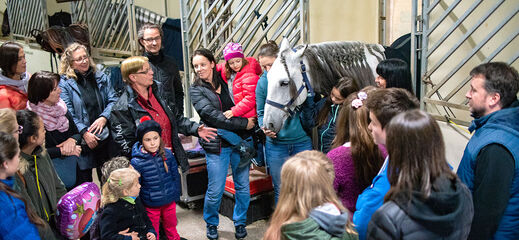ANIMAL WELFARE & HORSE KEEPING AT CAVALLUNA
THE HORSES ARE OUR STARS
The following applies to all our shows: Mostly, it's the horses themselves that move and inspire the audience. Many spectators have questions about the treatment of the animals behind the scenes and whether it's too stressful for them to be part of a show.
Every day we receive many questions about how the horses are kept through our social media channels. We have collected some of the most frequently asked questions - and provided detailed answers. Before we start, we would like to mention one thing: At CAVALLUNA, the welfare of the animals always comes first! These are not just words. It's a fact. Only happy horses can perform at their best in a show!
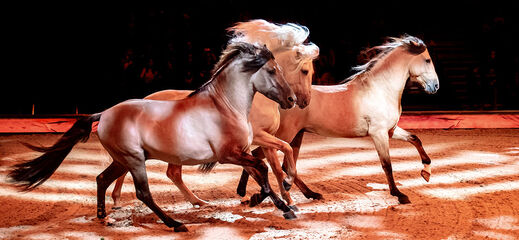
VETERINARY CARE
Are your horses kept in compliance with animal welfare regulations?
Animal welfare officials and independent veterinarians inspect all horses, stalls, transport vehicles and riding equipment in every single city on the tour. They pay attention to every detail and only when they are satisfied with their inspection can the show take place in the arena.
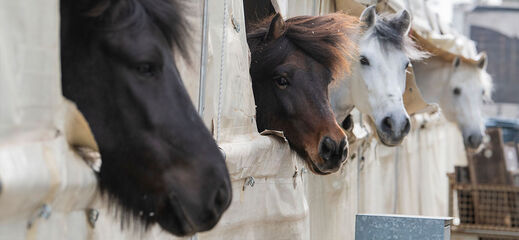
REGULAR GRAZING
Do your horses spend all day in boxes?
From Monday to Friday, the horses are kept in a centrally located stable, where they can relax in the pastures and paddocks after the show weekends, go for long rides or be exercised with light training. They always have the same "horse neighbours" and are always looked after by their keepers. The same applies to their accommodation in the mobile, heated stable tents that are set up at weekends: The size of the boxes in these tents meets the standards of any German stable, and double boxes are provided for larger animals such as the Shire Horses, so that each animal really does have enough space. As they are creatures of habit, care is also taken to ensure that the horses always have the same neighbours in the stables. Even in between shows, the riders take their animals out for a walk or a ride, depending on what is possible, so that even on show weekends, breaks for relaxation are guaranteed.
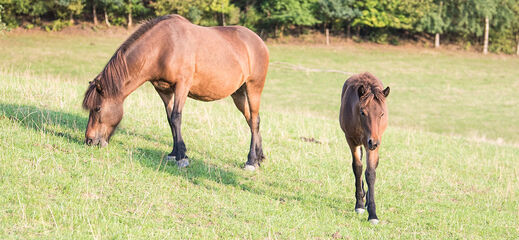
THE ANIMALS BELONG TO THE FAMILY
Who owns the horses?
The horses are owned by the riders or team leaders themselves. Most of the animals have been part of the teams and their families for many years, often trained from a young age by their owners, or in some cases even bred by them. During the tour, the riders are also the main contact for the horses, feeding them, cleaning their stalls, grooming them, preparing them for the show and training them together. Even on non-show days during the week, team members are always at the stables to ensure that their horses receive the best possible care. This is the only way to create the intimate relationship of trust between man and animal that such a show requires.
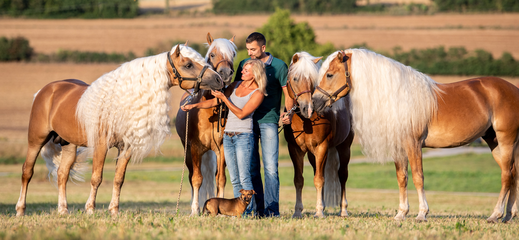
FORCE? NO CHANCE!
Horses are flight animals - isn't it cruel to put them in a show?
Most of the horses at CAVALLUNA are stallions. They have a natural urge to want to present themselves. In addition, of course, only animals with the right character for a show are selected. No horse in the world can be forced to show itself against its will in an aesthetic and carefree way. It will never be possible for a person to present a horse harmoniously in a free dressage or any other equestrian discipline if it is afraid or feels uncomfortable.
So once you have found a horse that naturally likes to pose and is willing to learn, it is trained for years and prepared for the show situation. Through months of work, the animals are sensitively accustomed to colourful lights, music, applause and so on. Furthermore, every horseman gives the animals the opportunity to get used to the conditions of each new show location.
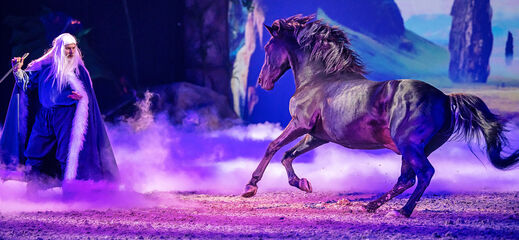
TRUST AND FRIENDSHIP AS A BASIS
Horses are flight animals. The horses in the Liberty dressage shows all have the opportunity to move away from their trainers unhindered, as they have no means of stopping them without ropes, halters or bridles. The same goes for the ridden horses: a 1.2 tonnes Shire Horse, for example, naturally has the strength and will to effectively resist its 50kg rider if it wants to escape the situation. It is a fact that the cooperation between animal and human being, as it is shown at CAVALLUNA, can only be based on trust and friendship, built up over many years, and nothing else.
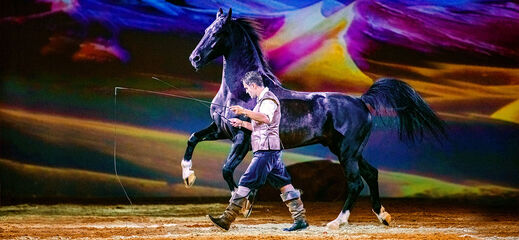
GETTING USED TO THE SHOW SITUATION
Isn't the music too loud for the horses?
CAVALLUNA has developed a sound system that provides the audience with a full sound, while allowing the horses in the ring to hear the music with no more than room volume. This is achieved by using convex loudspeakers directed away from the arena and towards the audience. A louder sound system in the arena is unthinkable and impossible because the artists communicate verbally with their animals. Applause is taught to the animals in training as positive feedback for their performance and is perceived as such in the show.
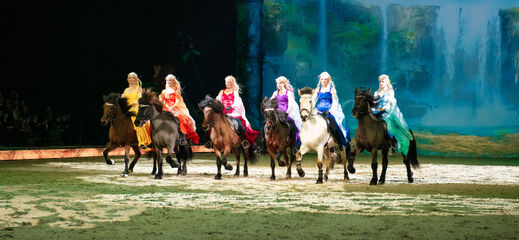
SHORT DISTANCES, MANY STOPS
Don't the horses suffer during transport?
The horses are transported from the CAVALLUNA stable to the show venues in professionally equipped horse transporters that comply with all the standards of the Animal Welfare Act. The central location of the stables means that journeys are kept as short as possible, but also many stops are made depending on the length of the journey. Our show horses are all old hands who are used to travelling and therefore don't find it stressful.
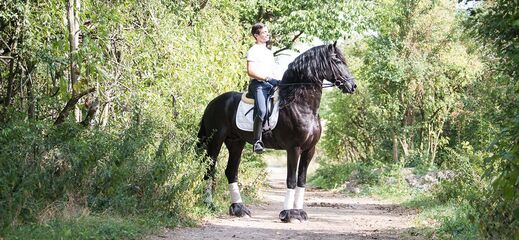
FORCE HAS THE OPPOSITE EFFECT
Do you ride or train your horses in hyperflexion?
Firstly, a brief explanation of what is meant by the term "roll": hyperflexion of the horse's neck is used as a training method in some equestrian disciplines, but is frowned upon in classical riding. The pulling down of the horse's head towards the chest by the reins leads to an unnatural and, above all, unhealthy posture of the horse's whole body and causes long-term damage to the spine, tendons, etc. We at CAVALLUNA believe that forcing a horse into an unnatural position, even for a few minutes, is harmful to the horse, weakens the relationship between horse and rider and is also unattractive to look at. As baroque breeds such as Iberians and Friesians in particular have an anatomical tendency to arch their necks upwards, there may be moments when a horse is a little too tight, but this is in no way desired or encouraged by CAVALLUNA riders.
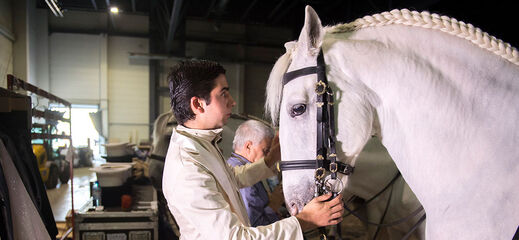
HAPPY HORSES
Our horses are trained for years, which is not only time consuming but also costly. It would not help anyone to deliberately harm their horse. It is possible for a horse to curl up on its own and try to avoid the aids. When this happens, any rider will try to actively work against this incorrect position. For this reason, it is wrong and unfair to riders to generalise any snapshots and suggest that unprofessional training methods are being used. You can be sure that it is in the interest of both the riders and CAVALLUNA that our animals are trained and kept in a species-appropriate manner and that they will be happy partners for a long time to come.
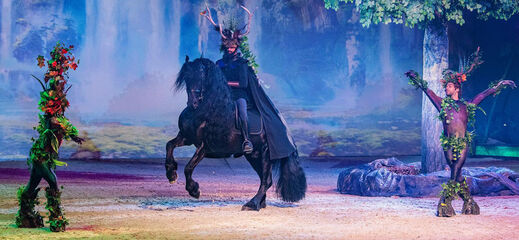
How can I see how the horses are kept?
For maximum transparency, before and after each performance, interested visitors can take a guided tour of the stables and see for themselves how the animals are kept, both in the stable tents and in the backstage area.

